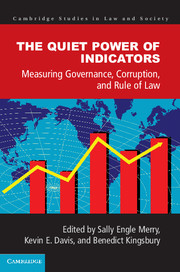Book contents
- Frontmatter
- Contents
- Notes on Contributors
- Acknowledgments
- Introduction: The Local-Global Life of Indicators: Law, Power, and Resistance
- PART I GLOBAL INDICATORS OF GOVERNANCE, CORRUPTION, AND RULE OF LAW
- 1 International Organizations and the Production of Indicators: The Case of Freedom House
- 2 Indicators and the Law: A Case Study of the Rule of Law Index
- 3 Measuring Corporate Accountability through Global Indicators
- 4 The Quest for Measuring Development: The Role of the Indicator Bank
- 5 Tradeoffs in Accountability: Conditionality Processes in the European Union and Millennium Challenge Corporation
- Part II INDICATORS IN LOCAL CONTEXTS
- Index
- Books in the Series
- References
3 - Measuring Corporate Accountability through Global Indicators
from PART I - GLOBAL INDICATORS OF GOVERNANCE, CORRUPTION, AND RULE OF LAW
Published online by Cambridge University Press: 05 June 2015
- Frontmatter
- Contents
- Notes on Contributors
- Acknowledgments
- Introduction: The Local-Global Life of Indicators: Law, Power, and Resistance
- PART I GLOBAL INDICATORS OF GOVERNANCE, CORRUPTION, AND RULE OF LAW
- 1 International Organizations and the Production of Indicators: The Case of Freedom House
- 2 Indicators and the Law: A Case Study of the Rule of Law Index
- 3 Measuring Corporate Accountability through Global Indicators
- 4 The Quest for Measuring Development: The Role of the Indicator Bank
- 5 Tradeoffs in Accountability: Conditionality Processes in the European Union and Millennium Challenge Corporation
- Part II INDICATORS IN LOCAL CONTEXTS
- Index
- Books in the Series
- References
Summary
INTRODUCTION
During the past two decades, there has been a drive to reduce complicated concepts to simple numbers. Corruption, rule of law, human rights, and more have all been reduced to quantitative “indicators.” Based on the theory that what gets measured gets done, government agencies have incorporated quantitative indicators into performance-based rules, information disclosure regimes, and self-regulation (see, e.g., Sunstein 1999; Sugarman and Sandman 2007; Carrigan and Coglianese 2011). These statistical tools have recently been used in international law to operationalize global norms and thereby improve compliance.
As a second-order abstraction of statistical information, indicators rely on numbers to represent social phenomena and evaluate performance. Backed by technical expertise and designed to produce comparability, these tools are shaping decision making by domestic and global regulatory bodies. For instance, the World Bank's Doing Business indicators produce a ranking of developing countries based on the quality of their business laws and legal institutions. The Bank's classification then influences its allocation of foreign aid as well as that of the US government through the Millennium Challenge Corporation. Domestic law has also incorporated indicators, as in the 2008 reauthorization of the Trafficking Victims Protection Act. This law relies on performance indicators to assess foreign governments' compliance with minimum antitrafficking standards and then categorize countries into three tiers. Given their propensity to simplify complex concepts and translate them into quantifiable measures, indicators are often used to regulate more intangible, value-laden issues such as the rule of law (as in the Freedom House indicators), corruption (as in Transparency International's Corruption Perceptions Index), and human rights (as in the indicators developed by the Office of the UN High Commissioner for Human Rights to monitor treaty compliance).
Indicators are playing an increasingly important role in regulatory governance (Davis, Kingsbury, and Engle Merry 2012). If used effectively, they can offer a number of apparent benefits: they can measure accountability to standards and norms; assess compliance with policies and specific targets; and evaluate performance with respect to stated objectives.
- Type
- Chapter
- Information
- The Quiet Power of IndicatorsMeasuring Governance, Corruption, and Rule of Law, pp. 103 - 132Publisher: Cambridge University PressPrint publication year: 2015
References
- 9
- Cited by

